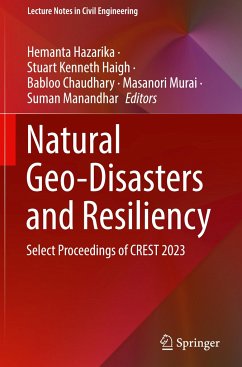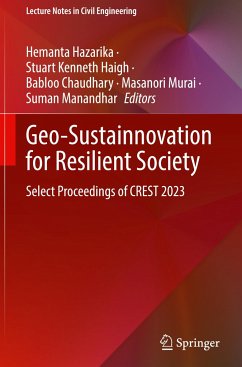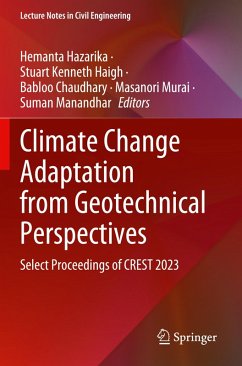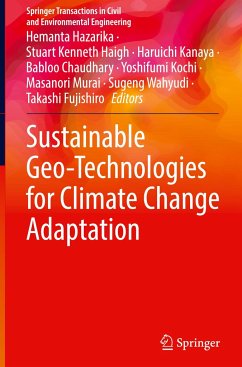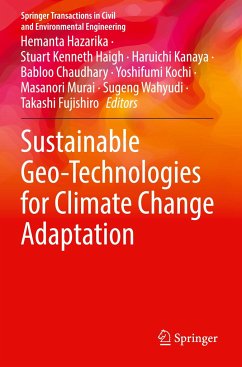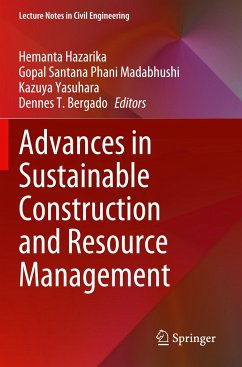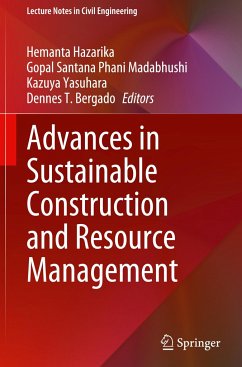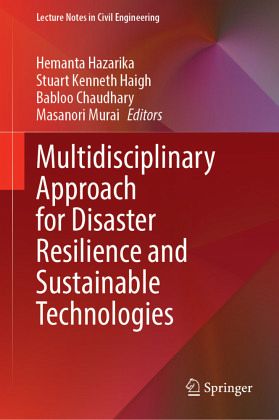
Multidisciplinary Approach for Disaster Resilience and Sustainable Technologies

PAYBACK Punkte
64 °P sammeln!
In the face of intensifying natural hazards and climate change impacts, this timely book brings together cutting-edge research and practical innovations in disaster mitigation, geotechnical engineering, and resilience planning.Spanning fifteen comprehensive chapters authored by global experts, this book addresses the urgent need for sustainable strategies to manage geotechnical risks in diverse contexts. It covers a broad spectrum of research and practices, including the requirements for sustainable disaster mitigation, simple prediction methods for rainfall-induced slope failures using digita...
In the face of intensifying natural hazards and climate change impacts, this timely book brings together cutting-edge research and practical innovations in disaster mitigation, geotechnical engineering, and resilience planning.
Spanning fifteen comprehensive chapters authored by global experts, this book addresses the urgent need for sustainable strategies to manage geotechnical risks in diverse contexts. It covers a broad spectrum of research and practices, including the requirements for sustainable disaster mitigation, simple prediction methods for rainfall-induced slope failures using digital elevation models and geological data, and sustainable ground improvement techniques for problematic expansive soils. The impact of climate change on landslide susceptibility, seismic landslides in loess deposits, and extreme rainfall-induced debris flow hazards are also addressed in detail.
The book further discusses methodologies for debris flow risk analysis, chain disasters observed in geotechnical engineering during the 2011 Great East Japan Earthquake, and community outreach through soft-type measures in disaster recovery. Additional chapters explore the engineering behavior of innovative materials for ground improvement, ground reinforcement including methods for earthquake-induced liquefaction mitigation of soils. Furthermore, modern analytical tools and techniques, including InSAR time series analysis for ground deformation, finite element analysis of slope stability considering soil anisotropy, and hydro-chemo-mechanical behavior assessment of geomaterials, are explained with practical relevance. Case studies and field applications offer insights into infrastructure resilience and the challenges of hazard-prone environments.
This book provides essential knowledge for practicing geotechnical and civil engineers, disaster risk management professionals, postgraduate students, and early-career researchers engaged in climate adaptation, infrastructure development, and sustainable geotechnical practices. It also serves as a textbook for graduate-level courses on disaster mitigation and geotechnical risk assessment.
Spanning fifteen comprehensive chapters authored by global experts, this book addresses the urgent need for sustainable strategies to manage geotechnical risks in diverse contexts. It covers a broad spectrum of research and practices, including the requirements for sustainable disaster mitigation, simple prediction methods for rainfall-induced slope failures using digital elevation models and geological data, and sustainable ground improvement techniques for problematic expansive soils. The impact of climate change on landslide susceptibility, seismic landslides in loess deposits, and extreme rainfall-induced debris flow hazards are also addressed in detail.
The book further discusses methodologies for debris flow risk analysis, chain disasters observed in geotechnical engineering during the 2011 Great East Japan Earthquake, and community outreach through soft-type measures in disaster recovery. Additional chapters explore the engineering behavior of innovative materials for ground improvement, ground reinforcement including methods for earthquake-induced liquefaction mitigation of soils. Furthermore, modern analytical tools and techniques, including InSAR time series analysis for ground deformation, finite element analysis of slope stability considering soil anisotropy, and hydro-chemo-mechanical behavior assessment of geomaterials, are explained with practical relevance. Case studies and field applications offer insights into infrastructure resilience and the challenges of hazard-prone environments.
This book provides essential knowledge for practicing geotechnical and civil engineers, disaster risk management professionals, postgraduate students, and early-career researchers engaged in climate adaptation, infrastructure development, and sustainable geotechnical practices. It also serves as a textbook for graduate-level courses on disaster mitigation and geotechnical risk assessment.




